
Search
Posts de la categoría ‘United Nations Events’
UNGA 2019 | MPPN Side Event ‘Call for action: Using multidimensional poverty indices to lead progress in the SDGs’
Highlights from the discussion included:
Eminent speakers
 H.E. Carlos Alvarado, President of Costa Rica
H.E. Carlos Alvarado, President of Costa Rica
“We started this path on 2014, and before that we were just measuring poverty by income, but what’s the problem of measuring poverty only by income? It’s a consequence, income is a consequence of the reality of people. So you do not really know what are the interlinked deprivations.”
“It is very important for every country to invest constantly in scientific and impartial data analysis.”
“When we developed this we worked with each minister of the cabinet that had something to do with this dimension so that the indicators were relevant for their work. Each indicator you can address with public policy. When you measure poverty only by income it’s everybody’s fault and nobody’s fault. When you measure poverty through specific indicators, you have a ministry of housing, you have a ministry of science and technology, a ministry of health, a ministry of labour, a ministry of education so those indicators are their indicators as well. This will allow you to have clear departure points and you can see your progress through time in the different variables. You can budget specifically in each dimension…and measure improvement to see if you can accomplish goals.”
“We launched in 2015, and it has been ground-breaking and has changed the paradigm in which we see poverty in Costa Rica.”
“What we see as the second generation, is …. administrative registration data… In Costa Rica we have a unique … living census to which you can apply multidimensional analysis…to tackle poverty directly not only by income, but by each of their dimensions.”
“We use a lifecycle approach…this means I asked the guys working there to show me the latest report of how many pregnant women there are in Costa Rica, and they showed me the current pregnant women in Costa Rica. It was approximately 50,000. I said ok, from that info, show me which of those women are in poverty. It was 40%, in extreme poverty – 10%. Of that 10%, show me which are 15-19, and it was about 300 pregnant women. We know them by name and address, so you can address a specific public policy to those future citizens which are going to be the most vulnerable, which means you can start building human capital before the child has even reached the earth.”
“We know all the households in extreme poverty which are not in any programme, those 37,000 are our next step, we know how to identify them, we can go directly to where the most poor and vulnerable people are, not only with cash transfer programmes but programmes in all dimensions to build human capital.”
OPHI is “a great team around the world and a great network around the world”.
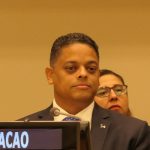 H.E. Eugene Rhuggenaath, Prime Minister of Curaçao
H.E. Eugene Rhuggenaath, Prime Minister of Curaçao
“To complement our work by including the voices and insights of the poor, we conducted a multidimensional poverty pilot survey in a neighbourhood, prior to delivering family-focused interventions. That programme has now been expanded into a broader social development agenda for the next two years, including family assistance and coaching and workforce development.”
“I welcome the efforts of the Seychelles, [to] focus on SIDs developing national MPIs… the way that SIDS experience poverty is often … very different than the way it is experienced in larger countries. National MPIs help us to see and effectively manage our different definitions of poverty”.
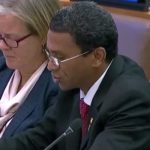 H.E. Barry Faure, Secretary of State for Foreign Affairs and the Blue Economy, Seychelles, delivering a message on behalf of H.E. Danny Faure, President of Seychelles
H.E. Barry Faure, Secretary of State for Foreign Affairs and the Blue Economy, Seychelles, delivering a message on behalf of H.E. Danny Faure, President of Seychelles
“Seychelles launched its pilot national Multidimensional Poverty Indices on 1st July this year, becoming the second High Income Country in the world after Chile to use the MPIs. We found that a multidimensional measure far better reflects the distinctive characteristics of poverty in our Islands. It allows us to analyse the pockets of poverty that exist in Seychelles, so that we can target interventions accordingly.”
“Later this year, the MPIs will become an official statistic of the government to inform policymaking, monitor progress in eradicating poverty, and be reported against Goal 1 of the SDGs.”
“The global MPI can play a critical role in ensuring no one is left behind. This is a people-centered index that reflects poverty as poor people often describe it, and captures the multiple deprivations the less fortunate face at the same time.”
“In July this year, Seychelles hosted the annual Meeting of the 58-country Multidimensional Poverty Peer Network, where we discussed how MPIs can accelerate progress towards SDG 1: No Poverty. As a community, we agreed to advocate for several critical points:”
“Firstly, although many countries have or are building MPIs, as yet no country can report their SDG indicators in the global database. So since 2015, even countries that update their MPI annually – such as Colombia – have not been permitted to upload their MPI into the global database. We request UN Statistics Division to address this matter urgently, and also request UNDP to consider being the custodian agency, so that countries are able to report on this important issue.”
“The second point: We propose that the global MPI be included as an indicator in SDG 1 to track global trends in non-monetary poverty. It seems odd that, while the SDGs address poverty in all its forms and dimensions, there is no indicator of multidimensional poverty alongside the $1.90/day measure.”
“We are pleased to note that the Global Sustainable Development Report uses the global MPI that UNDP and OPHI compute for this purpose. We call on this to be included in the Secretary General’s report each year on Goal 1, so that we can see how multidimensional poverty is changing at a global scale, and celebrate our success in 2030.”
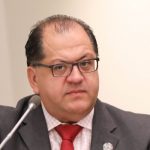 Luis Felipe Lopez Calva. Regional Director for Latin America and the Caribbean, UNDP delivering a message on behalf of Achim Steiner, Administrator, United Nations Development Programme
Luis Felipe Lopez Calva. Regional Director for Latin America and the Caribbean, UNDP delivering a message on behalf of Achim Steiner, Administrator, United Nations Development Programme
“We are at the four-year mark of the adoption of the 2030 Agenda for Sustainable Development.”
“As embodied in that agenda, “We learned that growth is uneven and volatile, and that well-being goes far beyond income. We recognized that while income is a necessary condition, it is by no means a sufficient one to secure well-being. We agreed that a monetary measure of poverty is not enough – we need to understand also the depth, persistence and complexity of poverty.”
“After a journey that UNDP supported since the beginning of this century and after a very close partnership fostered with Dr Sabina Alkire and Professor James Foster and others, next year will be 10 years since UNDP and OPHI first launched what was at the time the Multidimensional Poverty Index.
“While this index was originally received with trepidation from the development community, almost a decade later we can be certain that the thinking of development actors has converged towards this multidimensional approach. We have witnessed how the Index has triggered rich discussion among policy makers and development practitioners around the world.”
“Prior to that, UNDP was also the first to champion the reconceptualization of well-being beyond income, with its publication of the Human Development Index in the nineties. With it, it solidified the notion that progress meant much more than economic growth.”
“Arguably, the 2030 Agenda can be interpreted as the political consolidation of these different ways to think about development”
“To conclude, let me make two additional points: First, the Multidimensional Poverty Index has helped to improve our understanding of poverty in many countries.
“Second, the Multidimensional Poverty Index is an instrument for enhancing governance, acting as a policy coordination tool that encourages different sectors to align behind a common goal. Moreover, it fosters government accountability—as it allows progress to be widely scrutinized, lagging dimensions identified, and successes celebrated.”
“As we have done since the very beginning, UNDP reiterates its commitment to support the multidimensional approach to poverty and the MPI.”
Ministerial Discussion
 H.E. Teodoro Ribera Neumann, Minister of Foreign Affairs, Chile
H.E. Teodoro Ribera Neumann, Minister of Foreign Affairs, Chile
“In 2012, President Sebastián Piñera created the Presidential Advisory Commission for the Measurement of Poverty during his first presidential term. That commission recommended installing the Multidimensional Poverty Measurement in Chile as a complement to the Income Poverty Measurement. As a result of the recommendation, in December 2014, the Ministry of Social Development and Family determined its first Multidimensional Poverty Index (IPM) officially based on the methodology proposed by Alkire & Foster …. It was the result of a long process of discussion between the academy, civil society organizations and governments, and we tried to make it a tool that would have a lot of support from civil society and would survive succeeding governments so we could develop social policies that go beyond government administration…It is a tool for Chile, not a single government.”
“The MPI is one of the main indicators for the diagnosis of poverty and deprivation in Chile and has become a valuable tool to identify specific population groups, and regions that are excluded or are not supported in Chile’s development process. It also addresses the challenges included in the 2030 Agenda and its 17 Sustainable Development Goals.”
“If we don’t have medium and long term goals, social policies become electoral policies and electoral policies last until the day of the elections.”
“Chile not only measures multidimensional poverty, but also uses the official MPI to build social policies. What I wish to stress…it is important to measure poverty, but that is not the end, the end is to make poverty go down permanently.”
(In Chile where income has gone up) “Poverty is focussed in certain regions and certain groups, it is hidden but it is still there, there’s a new poverty in certain countries that results in the ageing of the population…. We noticed that poverty has changed in the country, it is another type, what is poverty?”
The Chilean government will host the eighth annual meeting of the Multidimensional Poverty Network (MPPN).
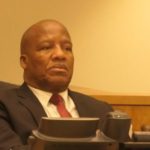 H.E. Jackson Mthembu, Minister in the Presidency, South Africa
H.E. Jackson Mthembu, Minister in the Presidency, South Africa
“Statistics SA has in recent years undertaken substantial work to broaden our understanding of poverty in the country. In conjunction with monetary measures we have developed the South Africa Multidimensional Poverty Index (SA-MPI)…employing the Alkire-Foster method…[which] enables us to track changes in levels of poverty over time and gives us evidence as to which indicators contribute most to poverty. It gives us a razor-sharp picture of poverty showing how many people are poor and what deprivations they have in order for our response to be swift and informed.”
“We must use the MPI together with the money metrics as an additional measure by our government to fight poverty. Using these combined tools enables us to gain a better picture to fight poverty.”
“Established less than a decade ago the MPPN is a very important structure in the world’s efforts to fight poverty.”
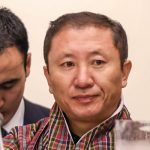 H.E. Tandi Dorji, Foreign Minister, Bhutan
H.E. Tandi Dorji, Foreign Minister, Bhutan
“Bhutan was the second country to officially launch the multidimensional poverty index in 2010 and the first to fully use the Alkire-Foster method… Since then both monetary and multidimensional poverty has reduced drastically.”
“In the last six years, our MPI declined from 12.7 in 2012 to 5.8 percent in 2017.”
“This is largely due to the wise commitment of the royal government over the past decades which has been further guided by the visions of our monarchs. Bhutan provides free healthcare, free education, extensive infrastructure development, and fast economic growth. We also use the MPI for targeted interventions, and also for allocating our scarce resources, using – as we call it – the resource allocation formulae for local governments.”
“Against this backdrop, there are two points to contribute…. First, we, like Mexico and Colombia and other first generation MPI adopters, are ready to complement our original MPI – that reflects acute poverty – with a moderate MPI.”
“Second, Bhutan has a…holistic perspective because of our concept of Gross National Happiness or GNH. Since 2008, our GNH Index has used the MPI methodology and its tools. Yet poverty and well-being and GNH are not the same. When we add to the MPI dimensions of culture, community, environment, governance, time use, and psychological well-being, we see more. And we see this trend gaining traction among our friends.”
“So I propose a Call to Action on Well-being: as the Human Development Reports of the UN reach 30 years and the SDGs reach 5 years, can we seriously explore Measures of Well-being that include and extend beyond MPI? …Using our GNH Index we can see person by person who lacks the conditions for Well-being and how we can improve those. We call also for action to learn together those policies that address subtler aspects of Well-being like social isolation or anxiety or the delicate yet profound topic of spirituality.”
“In an era of rising inequality, let us firmly commit to both ending poverty in all its forms, for everyone, and expanding well-being in all its forms, for everyone.”
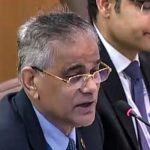 H.E. Shamsul Alam, Member (Senior Secretary), National Planning Commission, Bangladesh
H.E. Shamsul Alam, Member (Senior Secretary), National Planning Commission, Bangladesh
“The Government of Bangladesh recognizes the multi-dimensional nature of poverty and the need to address the problem by adopting appropriate policies and strategies.
“We estimate child MPI first….Why? They make up 47% of the poor and are more susceptible to abuse, exploitation and natural disasters. Many issues linger throughout their lives.”
“We’ll release the child-focused poverty measure and then go on with the process of the National MPI immediately.”
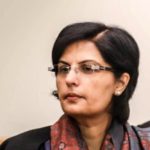 H.E. Sania Nishtar, Special Assistant to the Prime Minister, Pakistan
H.E. Sania Nishtar, Special Assistant to the Prime Minister, Pakistan
“We believe the MPI is highly relevant to the SDGs and related measurements. I am pleased to report that both MPI and SDGs feature prominently in Pakistan’s recently launched umbrella initiative Ehsaas, which aims to address poverty and inequality.”
“11 out of the 17 SDG goals are firmly embedded in the Ehsaas framework.”
“In terms of the metrics, we have used both consumption based estimates as indicators of monetary poverty as well as the MPI as a measure of non-monetary deprivations to establish baselines for the Ehsaas initiative. We note that MPI reporting has been stipulated in SDG 1.2.2 and I’m pleased to convey that as a member of the MPPN, Pakistan will report its MPI metrics as soon as the UN opens the relevant portal, which I believe is scheduled for 22 October this year.”
“We are committed to data disaggregation by gender, by income quintile, and on geographical bases, which we believe is the first step to understand the local drivers of poverty.”
“Our new nationally representative social and living standards measurement survey for 2019 is in the field and is powered for such disaggregation and we will use these data for the new MPI figures which we hope to release by the middle of next year.”
“The Ehsaas framework includes the national strategy for the development of statistics to strengthen the quality and availability of statistics by the Pakistan Bureau of statistics. We would like to ensure independence of statistics so the government has access to a credible and reliable base of evidence which we believe is critical to support the design and evaluation of policies.”
“We believe data and evidence are crucial for decision-making in Ehsaas, because the Ehsaas framework is aimed at those who are most in the need for help – the extreme chronic poor, those who suffer catastrophic risks, orphans, widows, the homeless, the disabled, the jobless, poor farmers, labourers, the sick who risk impoverishment, the undernourished, students from low income backgrounds, poor women and elderly citizens.”
“We believe that Ehsaas is unique, and I say this with humility, because it is the most ambitious poverty-centred umbrella initiative the Pakistan government has ever undertaken with its 134 policies and programme elements. It is both multisectoral as well as multi-stakeholder based. And it is embedded in theory of change, which is reflected in its four pillars: action against elite capture, safety nets, livelihoods and jobs, and human capital formation… The Ehsaas strategy has been released 10 days ago and can be accessed on our website. We invite all of you to comment on this framework and we look forward to our collaboration with the network to share lessons and to learn from all of you.”
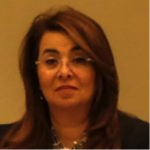 H.E. Ghada Fathi Wali, Minister of Social Solidarity, Arab Republic of Egypt
H.E. Ghada Fathi Wali, Minister of Social Solidarity, Arab Republic of Egypt
“The MPI has a sound methodology to help track progress towards the achievement of SDGs in general and for combating poverty and ultimately monitoring how the different dimensions are interlinked to accelerate progress across the 17 goals of the SDGs. Actually we find it very useful to allow global analysis as well. Not just compare within the country, but also compare between different countries. The disaggregation of data is vital for the equitable analysis of multidimensional poverty. The importance of using the MPI to compare different countries and compare within the same country and within the same region in the country is very useful to us. However, and as the Minister from Chile has mentioned, we still have this political challenge of agreeing what are the indicators and how often we should measure that.” “I still believe that we still need a lot of capacity building within countries and between countries and a lot of sharing information and tools so we can make this an accessible and user-friendly tool so that different countries can use and exchange notes. I find the Network very useful, however we still need extra work to invest in capacity building, developing policy tools and publishing policy notes.”
On the Egyptian programme, ‘Dignified Life’, launched by the Presidency, which is targeting 1000 poorest villages with cross-sectoral policies “The most important element in this initiative is the voice of the people, we collect and listen to the people in the villages… and we listen to their needs. It is very interesting how you can relate the elements and the indicators of the MPI to what people really think is important and is of relevance to them which makes it a true good governance tool, not just a measurement tool, not just a policy tool, but a good governance tool because there is this element of partnership and this element of participation of the people.”
“I do congratulate the different countries who have published their MPI reports. We are working on this multidimensional MPI with great enthusiasm, with great interest in making it a national tool for Egypt. We are still at the level of building the capacity and coordinating with the Ministry of Planning, the Ministry of Finance, because this is not the job of one ministry, it has to be a consensus at the political, at the highest level, and there has to be communication and understanding for the people at the village level of what we are measuring and why we are measuring it.”
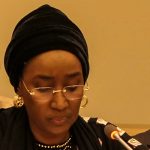 H.E. Hajiya Sadiya Umar Faruk, Minister for Humanitarian Affairs, Disaster Management and Social Development, Nigeria
H.E. Hajiya Sadiya Umar Faruk, Minister for Humanitarian Affairs, Disaster Management and Social Development, Nigeria
“In his first time in office between 2015 and 2019, the government successfully empowered more than five million people out of extreme poverty through its national social investment programme. Following this success the President announced the plan to empower 100 million people out of poverty in the next 10 years. He declared that by the end of eight years, we will have laid the grounds for lifting 100 million Nigerians out of poverty. This outcome will fundamentally shift Nigeria’s trajectory and place us among the great nations. This aspiration takes into cognizance the country’s current estimated population of about 200 million people and following this announcement – the 100 million out of poverty mandate kicked off with the establishment of a Ministry to coordinate these multi-sectoral efforts. That is the Ministry of Humanitarian Affairs, Sustainable Management, and Social Development. The Ministry will coordinate with different government agencies, donor organisations, and private investors to shape policies and drive real impact.”
“With the support of the President we use the MPI data to foster governmental accountability to citizens by indicator tracking of ministerial performance.”
“Also we will support and work closely with the national bureau of statistics to conduct regular multidimensional poverty measurements alongside monetary measures at national and subnational levels to understand our true poverty status and use findings to continue shaping public policies.”
“We will create a national and state poverty map/tracker to provide a vivid representation of progress towards our end poverty goal.”
“In collaboration with the Ministry of Finance, Budget and National Planning, we will use MPI data to improve budget allocations by sector and State, with the aim of better targeting beneficiaries of the 100 million Out of Poverty mandate.”
“We will facilitate a bi-annual multi-stakeholder, multisector National Roundtable on the reduction of Poverty and Inequality.”
“These strategies demand a multilateral approach where the three arms of Government: Executive, Legislative and the Judiciary, work towards this common goal. Achieving the SDGs and specifically, SDG 1: Eradicating extreme poverty by 2030, also calls for regional and global efforts.”
“You will agree with me that the road to SDG 2030 looks bright and promising given today’s conversation. My optimism is premised on the assumption that when Nigeria extends its hand to support and request support in regards to the 100 million Out of Poverty mandate, the MPPN, UNDP, donors, countries, regions, and the good people of the world, will rise to the occasion, and act in partnership as we jointly seek to end poverty and reduce inequality. Our destinies are linked; the goal is common; and time can’t wait. Let us join hands together to make this happen.”
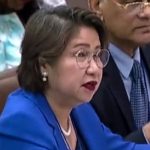 H.E. Rosemarie G. Edillon, Policy and Planning Group, National Economic and Development Authority (NEDA), Republic of the Philippines
H.E. Rosemarie G. Edillon, Policy and Planning Group, National Economic and Development Authority (NEDA), Republic of the Philippines
“We fully subscribe to the ambition of Goal 1 of the 17 Sustainable Development Goals (SDGs) which calls for addressing poverty in all its forms, in all its dimensions. This is where the Multidimensional Poverty Index (MPI) comes in handy. In addition to income-based measures, MPI enriches our poverty analysis by highlighting the deprivations of the poor.”
“The initial set of the Philippine MPI results released in November 2018 covers 4 dimensions – namely, (1) education, (2) health and nutrition, (3) housing, water and sanitation, and (4) employment. There are 13 indicators under these dimensions.”
“Preliminary results show that, in 2017, there were 17.3 percent of Filipinos who were multidimensionally poor or were deprived in at least one third of the indicators, an improvement from the 23.9 percent in 2016.”
“Digging deeper, initial results indicate that education has the largest contribution to the overall multidimensional poverty index”
“These initial results sent ripple effects to the public education sector…. Consequently, there is now a call for greater budget allocation.”
“We intend to fully utilize the MPI to inform policy and resource allocation. Out next MPI will be based on our Family Income and Expenditure Survey.”
“As we pledge to leave no one behind, we have to get better at identifying where the poor have serious deprivations. Hence, we support the adoption and development of alternative poverty measures such as the MPI.”
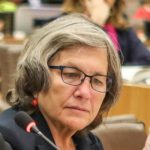 H.E. Trudi J. Renwick, Assistant Division Chief, Economic Characteristics, Social, Economic and Housing Statistics Division, US Census Bureau
H.E. Trudi J. Renwick, Assistant Division Chief, Economic Characteristics, Social, Economic and Housing Statistics Division, US Census Bureau
“Last May the US Census Bureau published its first report on multidimensional deprivation. Using data from our American community survey the report looks at six dimensions: standard of living, education, health, economic security, housing quality and neighbourhood quality. The report found that 15.4% of the US population in 2017 faced two deprivations. The majority of these were characterised as in poverty using our pre-tax unidimensional income poverty measure. But, there was a considerable part of the population, 4.6%, who were not income poor, but faced deprivations in two other areas. At the state level, there were 20 states and the District of Columbia where the MDI was higher than the official poverty rate. There were 16 states where the official poverty rate was higher, and 14 where the differences were not statistically significant. Decomposing the MDI we found that standard of living and housing quality contributed the most to the measure particularly for children and working age adults. Looking at race and ethnic origin, blacks and hispanics were over-represented in their shares of multidimensional deprived population relative to their share of the overall population. Our research into this exciting new approach will continue. Dr Glassman is currently working on implementing a conceptually similar measure of multidimensional poverty in other household surveys.”
Development Partners
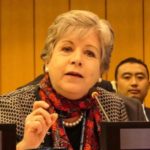 Ms. Alicia Bárcena, Executive Secretary, UN – Economic Commission for Latin America and the Caribbean
Ms. Alicia Bárcena, Executive Secretary, UN – Economic Commission for Latin America and the Caribbean
“Monetary policies are useful but multidimensional poverty does give you a sense of deprivations of housing, education and health”
“We have to improve the metrics. We have to make sure we are using rigorous systems to allow us to see trends”
“We see two sets of countries (1) Uruguay where public policy effectively invests in labour policies which are linked in income (2) Costa Rica with effective investment in social policies.”
“We need to collaborate to build a measure that includes multidimensional comparison in a regional index.”
“If we improve the metrics, we can have a policy design that can be better, because monetary poverty, the way we measure it, is about income, but multidimensional poverty is entering another issue which is public policy on housing and health, which not necessarily provided by income only, so it is important that we distinguish these two when we formulate public policy.”
H.E Ahmed Aboul Gheit- Secretary General of the League of Arab State. Delivered by H.E Hayfaa Abu Ghazaleh, Assistant Secretary –General, Head of Social Affairs Sector.
Due to time constraints we were unfortunately unable to hear the statement from the League of Arab States in full. Please find it here.’
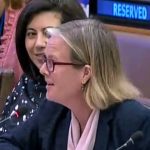 Ms. Carin Jämtin, Director General Swedish International Development Cooperation Agency
Ms. Carin Jämtin, Director General Swedish International Development Cooperation Agency
Due to time constraints we were unfortunately unable to hear the statement from Sida in full.
“We are proud partners of OPHI and that is because measuring poverty must be about more than money.”
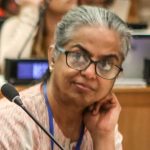 Ms. Vidhya Ganesh, Director of Division of Data, Analytics, Planning and Monitoring (DAPM), UNICEF
Ms. Vidhya Ganesh, Director of Division of Data, Analytics, Planning and Monitoring (DAPM), UNICEF
Due to time constraints we were unfortunately unable to hear the statement from UNICEF in full.
According to the global MPI, “The numbers are really staggering, 663 million children live in multidimensionally poor households and one third of them are under the age of five. This is pointing at how to use the measurement for policy programming and governance. I think that we have a real task ahead of us, and we are very happy to collaborate with the MPPN network.”
Remarks from the floor
H.E. Alejandro Murat Hinojosa, Governor of Oaxaca State, Mexico
H.E. José Aguilar, Executive Director, Horizonte Positivo, Costa Rica
Recording of the session here.
Global Sustainable Development Report: here.
[1] The SDG Summit is the first UN summit on the SDGs since the adoption of the 2030 Agenda in September 2015. Its purpose is for Heads of State and Government to follow up and comprehensively review progress in the implementation of the 2030 Agenda for Sustainable Development and the 17 Sustainable Development Goals (SDGs).
UN Statistical Commission 50th Session – MPPN Side Event 2019
On 5th March 2019, the Multidimensional Poverty Peer Network (MPPN) hosted a side event at the 50th United Nations Statistical Commission titled “Multidimensional Poverty: Measurement for Action.” More than 70 statisticians and other stakeholders gathered in New York to discuss progress and issues with developing and implementing multidimensional poverty measures to reduce poverty and encourage policies that leave no one behind in the pursuit of the Sustainable Development Goals (SDG’s).
The side event was collegially chaired by Risenga Maluleke, the Statistician-General of Statistics South Africa. Speakers included representatives from OPHI and Directors of Statistics from Angola, Chad, Colombia, Kenya, Libya, Malaysia, Mexico, Mongolia, Nepal, Nigeria, Palestine, Philippines, Senegal, Sudan and Uganda.
Highlights include the following:
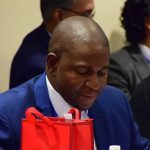 Risenga Maluleke, Statistician-General of Statistics South Africa.
Risenga Maluleke, Statistician-General of Statistics South Africa.
“The next hour will be a real feast of interest. You will hear a cascade of presentations from 14 National Statisticians on multidimensional poverty metrics and how these are used in action to complement monetary poverty measures and fight poverty in all its dimensions.”
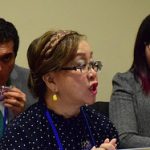 Lisa Grace Bersales, National Statistician, Philippines
Lisa Grace Bersales, National Statistician, Philippines
“When we reported the MPI to our Philippines Statistics Authority Board, we told the different ministries that we will tell you where most Filipino families are most deprived. And when our Ministry of Budget heard this, they said: ‘Oh, we want to know that.’ Because when we approve proposals of budgets of certain sectors—health, education, labor—we want to know if indeed these are where the budget should be… So it’s not just about policy, but it’s also about where government financing will prioritize. This is really what we wanted the MPI to be focused on.”
See press release from the Philippines here
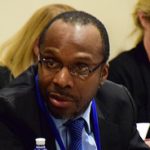 Yemi Kale, Statistician General, National Bureau of Statistics, Nigeria
Yemi Kale, Statistician General, National Bureau of Statistics, Nigeria
“As far as policymakers are concerned, you see them asking for disaggregation of the MPI. It’s not just at the national level, but also at the state level. States want to know which deprivations are worse and you can see them actually designing policies to tackle certain areas.”
“This can also be used to locate where the poor are. So the National Social Safety Net was designed using the MPI numbers across different states to target those states and areas with the highest deprivations. And you can see that the policies were targeted towards those areas in designing the entire policy framework.”
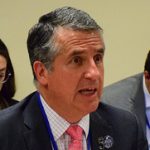 Julio Santaella, President, National Institute of Statistics and Geography (INEGI), Mexico
Julio Santaella, President, National Institute of Statistics and Geography (INEGI), Mexico
“In the definition of these variables [that go into the multidimensional poverty measure], of course, there is a huge and intense discussion between INEGI, the statistical office, and CONEVAL, the council, because we have to come up with implementation of these definitions. So it’s not only important to be conceptually rigorous, but it also has to be feasible to be applied on the ground.”
“Right now we are almost at 10 years of this measurement, and CONEVAL is going to redefine the methodology. The law has upgraded some of the rights—so, for instance, the level of education has gone beyond primary that is mandated by law to secondary level—so that is something that has to be included into this measure.”
 Juan Daniel Oviedo Arango, Director General, National Administrative Department of Statistics (DANE), Colombia
Juan Daniel Oviedo Arango, Director General, National Administrative Department of Statistics (DANE), Colombia
“The MPI is measurement for action because, at the first glance, we use the MPI as an accountability platform of how social policies are going to improve life quality conditions of our citizens.”
“The MPI not only was used as an accountability platform but also as a strategic policy designing instrument. So all the socio-economic policy of our government turned around the MPI.”
“The MPI is also a very good example in our country of good governance. An MPI needs rigor and independence in the measurement because it cannot be just a government-biased indicator, but it has to be really independent.”
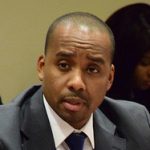 Nour Goukouni Nour, Director General, National Institute for Statistics, Economic and Demographic Studies (INSEED), Chad
Nour Goukouni Nour, Director General, National Institute for Statistics, Economic and Demographic Studies (INSEED), Chad
“For a better evaluation of the Sustainable Development Goals, and especially to have information to feed into the 2017-2021 Five-Year Plan, it is important to develop socioeconomic indicators that can capture, from many angles, the indicators of poverty in a multidimensional approach.”
“The results of the MPI will provide the Government with the necessary information to better guide public policies in measuring poverty and well-being, to geographically target vulnerable groups, to monitor and evaluate poverty reduction, and to monitor SDG indicators.”
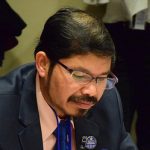 Mohd Uzir Mahidin, Chief Statistician, Department of Statistics, Malaysia
Mohd Uzir Mahidin, Chief Statistician, Department of Statistics, Malaysia
“In line with the introduction of the MPI in the 2010 Human Development Report, Malaysia has developed a national measurement of MPI that is appropriate to the socio-economic well-being and development framework of the nation. The use of the MPI will ensure that policy evaluation will shift beyond poverty to include vulnerability as well. The MPI will complement the BLI measure and monetary poverty from a multidimensional perspective.”
“The MPI we compute reflects both the incidence of multidimensional poverty deprivation, as well as the intensity.”
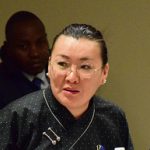 Ariunzaya Ayush, Chairperson, National Statistics Office, Mongolia
Ariunzaya Ayush, Chairperson, National Statistics Office, Mongolia
“In 2017, Mongolia conducted a pilot survey and covered three counties. We tried to measure the MPI in four dimensions, having Education; Health; Housing conditions; and Standard of living. … We understood that we had to organise discussions on selected indicators between multi-stakeholders in the government to see which indicators we need. So we are working now with the World Bank on projects, taking deeper surveys on nomadic households and we also have an ADB project which is working on SDG indicators, and especially working on Multidimensional indicators.”
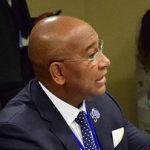 Camilo Simão Ferreira de Ceita, Director General, National Institute of Statistics, Angola
Camilo Simão Ferreira de Ceita, Director General, National Institute of Statistics, Angola
“… what we need to do is come up with our own definitions for our own MPI, so we started the process with OPHI’s support through a national consultation to define the dimensions and the indicators. We think the dimensions will be Health; Education; and Standard of Living. We count on the support of Statistics South Africa, they have a lot of experience in this issue, and of course on OPHI to give us support and I think it will happen in May. I think this will be a revolution about poverty in Angola.”
Abdella Zidan Allag, Chairman, Bureau of Statistics and Census, Libya
“We took an opportunity because there was a survey done in 2016 and we used that data to measure the MPI for Libya. We concentrated on three dimensions – Work and Education as one dimension; Health; and Living Standards. The values from this index are reliable because when we go through them, they show the truth of poverty in Libya. This report has succeeded in providing indicators we can rely on because we didn’t have a measure before, so this is a great opportunity for us to have indicators to assess the first goal of the SGD’s.”
Palestine Central Bureau of Statistics
“In 2014, we started working on the MPI with the national committee in Palestine and with consultants from ESCWA. We also conducted the households consumption and expenditure survey in 2016/2017, and we also have the census 2017 – we are working on the MPI using the big survey and the census. The National Policy Agenda 2017-2022 highlights “Putting Citizens First”, and in response to that, we are working to have Multidimensional variable design besides the income line”.
 Babacar Ndir, Director General, National Agency of Statistics and Demography (ANSD), Senegal
Babacar Ndir, Director General, National Agency of Statistics and Demography (ANSD), Senegal
“In Senegal the MPI was developed by the Observatory of Quality and Living conditions. The Observatory is an association of government and statisticians – like Ministry of Economy, the ANSD, Ministry of Social Development, Social Economy and so and so. Also, the private sector and civil society. And this framework has been put place to better take into account the implications of the MPI in public policies. The process of developing the MPI has followed different steps suggested by the Alkire-Foster methodology. The steps are as follows – first was to analyse the existing situation. The second step was to set the units of identification, and the third is to choose MPI parameters. And this choice developed slowly, and 5 dimensions were selected – Education; Health; Reading Conditions; Employment; Governance and Institutions.”
Imelda Madgalene Atai, Acting Executive Director, Uganda Bureau of Statistics
“The analysis of the MPI is based on the 2016/17 Uganda National Household Survey (UNHS 2016/17), UDHS 2016, and the UNPS. The Alkire Foster (AF) methodology is adopted in the estimation of multidimensional poverty at national, rural/urban and sub-national levels (Alkire and Foster, 2011). The AF framework employs the dual-cut off approach (deprivation cut off and poverty cut off) to identify the poor. For the Uganda MPI, a household (and all its members) is considered poor if they fall short or is deprived in 40 percent of the weighted dimensions.
Dimensions and indicators for Poverty Include: Education, Health, Living Standards, Empowerment”
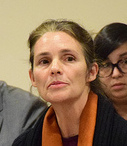 Sabina Alkire, Director, Oxford Poverty & Human Development Initiative, University of Oxford
Sabina Alkire, Director, Oxford Poverty & Human Development Initiative, University of Oxford
“Some countries launched their National MPI’s in 2018 and are not here, like Nepal. And also, Child MPI’s like Panama. Also, in 2019, Sierra Leone, the President, released their National Development Report with their National MPI last week – so that’s the first of 2019 and there will be more countries launching official MPI’s in 2019.
The MPPN works mainly on national statistics, but also with many agencies – and national MPI’s are permanent official statistics like a monetary measures – which both reflect poor peoples’ experiences and also reflect the policy priority, including the SDG agenda at the national level. So we are very happy that to support this with UNDP we are releasing a new book shortly – it will be online – “How to build a National MPI” – It has both the statistical process and the policy process in the same book.
We are very grateful to each person here. And there are many here who haven’t spoken but whose expertise we really value and recognise. This is a network of people who are terribly committed, and I think by working together we can move this forward to the benefit of those we are working on behalf of.”
See power point presentation here
Pictures are available here.
2018 UNGA | MPPN Side Event: Using the MPI to guide innovative policies to eradicate poverty in all its dimensions
The event followed the 20 September 2018 joint release by OPHI and the UNDP Human Development Reports Office of the updated global Multidimensional Poverty Index (MPI) data for 2018. The 2018 global MPI includes adjustments to indicators so that the global MPI better aligns with the SDGs.
Highlights from the discussion included:
 H.E. Juan Carlos Varela, President of Panama
H.E. Juan Carlos Varela, President of Panama
My government adopted the Multidimensional Poverty Index as a decisive step to change the paradigm of development in our country placing the human being in the center, giving name and face to the figures and statistics. The MPI allowed us to capture those dimensions of human poverty that constitute an obstacle to development, serving as a fundamental tool for the development of policies and the allocation of resources with social criteria.
For this reason in 2017 we were the first country in Latin America and the Caribbean to develop the first MPI for children and adolescents in the region. Experience that today we make available to all the countries that make up the Multidimensional Poverty Network as a step towards the correct direction towards the fulfillment of the first Sustainable Development Goal (SDG). This new instrument makes it possible to capture the hardships suffered by children and adolescents and understanding that they are different from those suffered by adults, have much deeper and permanent effects, so as to guide and monitor the policies of each State that guarantee development.
 H.E. Juan Orlando Hernández, President of Honduras
H.E. Juan Orlando Hernández, President of Honduras
As a government we were always convinced that poverty should not be measured only by income but in a multidimensional way and I particularly want to share with you that having been born in the rural sector of my country and grown up and lived in cities, I understood better why we should not measure only the issue of income. In the rural sector you can live with less money and live more comfortably, I tell you from experience.
In the measurement of Multidimensional Poverty we have had the following benefits: 1. Follow up and evaluate the program Vida Mejor as a multidimensional platform to serve the most needy and that allows us to make adjustments to achieve more efficiency and effectiveness. 2. Substantially improve inter-institutional and intersectoral coordination with comprehensive intentions. 3. Targeting poverty at the territorial level, attention to ethnic groups and vulnerable groups. 4. The identification of a specific group, for example, attention to early childhood, preschool education, attention to coverage of education from seventh to ninth grade.
 *H.E. Epsy Campbell Barr, Vice-President of Costa Rica
*H.E. Epsy Campbell Barr, Vice-President of Costa Rica
I would like to emphasize what it means to have this perspective of multidimensional poverty and of its counterpart multidimensional development and put it in the context of the 2030 Agenda for Sustainable Development. Costa Rica has understood that it assumes a more comprehensive perspective, a transformative perspective, a perspective that look at the lives of people in all their dimensions, their own well-being and that really is a qualitative contribution.
We came from a time when the approach to poverty issues was limited not only to income but also was not framed in a general umbrella of development. Not leaving anyone behind is a responsibility but it is a responsibility in perspective in which we clearly have the development standards where we believe that people should be, where citizen action should be based and where we should place the different actors of the society to generate the commitments related to the development of the sectors that have been most violated. The implementation of this methodology allowed Costa Rica to reduce Multidimensional Poverty from 20% to 18%, 20 thousand families managed to get out of poverty precisely because we had the possibility of doing a much more comprehensive approach. We believe that this perspective of poverty and multidimensional development is a more complete perspective that allows us to analyze in a better way the situation of vulnerability that some family members encounter, but it is also the path that we must take to achieve the Sustainable Development Goals.
Our experience in implementing the Multidimensional Poverty Index has not only improved and transformed public policy in our country, but has allowed our actions to have an impact on the daily lives of thousands of people. Many of those people are women who they found themselves in a situation of absolute exclusion.
 Luis Felipe López-Calva, UNDP Regional Director for Latin America and the Caribbean
Luis Felipe López-Calva, UNDP Regional Director for Latin America and the Caribbean
“We jointly with OPHI presented global numbers for MPI that showed three main messages: there are 1.3 billion MPI poor people in 104 countries for which data were available, half of them are children, and this represents about 25% of the total population in these 104 countries.”
“…the MPI process has led, at the national level, to a process in which there are many actors who are convening to discuss what it means to be poor in that context, so they discuss what are the dimensions, what are the thresholds, and what are the challenges to define poverty in that specific context. The process itself has a lot of value. …it has become also an instrument for policy coordination… it has also allowed us to identify better information gaps and to improve national information systems. And finally, it has also become an instrument of accountability.”
 H.E. Rosemarie G. Edillon, Deputy Director General, National Economic and Development Authority, Philippines
H.E. Rosemarie G. Edillon, Deputy Director General, National Economic and Development Authority, Philippines
“Back in 2015, our agency, the National Economic and Development Authority sought to determine the aspirations of Filipinos over the long term, a span of 25 years. We conducted a nationwide survey where we asked respondents, numbering 10,000 what they want to be, to do and to have by 2040. We have summarized the results into three broad aspirations: to enjoy strongly-bonded relationships, to live a comfortable lifestyle and to feel secure about the future. Clearly, increasing income is but one of the many factors that figure into the aspirations of Filipinos.”
“The multidimensional poverty index (MPI) presents itself as an alternative measure of poverty. Actually, I would say that it is more relevant in depicting poverty as it is closer to the concept of a comfortable lifestyle; if you are multidimensionally poor, then you are not enjoying a comfortable lifestyle. It is also ideal for identifying the poorest of the poor, as it depicts multiple deprivations. It also provides an objective method for identifying beneficiaries of targetted assistance programs. In addition, it makes for easier and less expensive data collection.”
 H.E. Shamsul Alam, Member (Senior Secretary), National Planning Commission, Bangladesh
H.E. Shamsul Alam, Member (Senior Secretary), National Planning Commission, Bangladesh
“The government of Bangladesh recognizes the importance of the multidimensional nature of poverty”.
“We should try to include indicators that are not only relevant to the country context but also comparable to the global perspective.”
 H.E. Nabeela Tunis, Minister of Planning and Economic Development, Sierra Leone
H.E. Nabeela Tunis, Minister of Planning and Economic Development, Sierra Leone
…the many faces of poverty cannot be captured by income measures alone. Knowing not just who is poor but how they are poor is essential for effective human development programs and policy decisions.
This straightforward yet rigorous index allows us in government to understand the various sources of poverty at the national as well as the subnational levels for our various population groups and as such be able to target the human development plans accordingly. We have derived our national development priorities for the next couple of years from the MPI analyses. It has given us a direction of where we want to go and how we want to get there.
H.E. Carlos Velasquez Monge, Minister of Social Development, Guatemala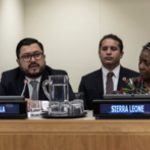
We are taking a giant step forward by joining the Multidimensional Poverty Network and creating our own multidimensional poverty index. The development of our Multidimensional Poverty Index will help ensure that budgeted resources are properly targeted for our social programs.
Guatemala will launch its Multidimensional Poverty Index next December and we are sure that with this will change the concept of poverty at the national level, but we are also confident that we will be able, through this index, to be effective in the methodology of our social programs.
 H.E. Risenga Maluleke. Statistician General South Africa
H.E. Risenga Maluleke. Statistician General South Africa
The reason South Africa is in favour of using the SAMPI, is because the SAMPI looks at deprivation in multiple aspects of life such as education, health, asset ownership, economic activity and others. And of course put all identified aspects together in an index to measure poverty, it helps to evaluate the effectiveness of poverty reduction strategy implemented since the dawn of our democracy.
SAMPI indicates that the contribution of government social wage program towards poverty reduction, the contribution of government poverty reduction programs such as fee-free schools, free primary healthcare, access to free basic services, provision of free formal housing, and others, are captured in the SAMPI. However, many of these services are difficult to quantify in monetary terms, especially at household level.
There’s a great effort made by StatsSA to ensure that SAMPI is used in policy making. We are in the process of discussing with relevant stakeholders to make the SAMPI the official permanent poverty measure.
H.E. Oliver Arroyo, General Director for Evaluation and Monitoring of Social Programs, Mexico
A further example of the application of the MPI as a guiding criterion of public policy is the construction of the Poverty Observatory. This interactive online public platform, which seeks to show the assessment of poverty and its dimensions among other development indicators, will allow SEDESOL to address three aspects: 1. Indicate the evolution of poverty at the national, state and municipal levels. 2. Analyze poverty and its targeting so that states and municipalities can more effectively address structural poverty at the local level. 3. A repository of good practices in the fight against poverty derived from the experiences of other states and municipalities.
H.E. Ghada Waly, Minister of Social Solidarity, Egypt
Egypt has been going through fundamental changes where the are serious concerted efforts to achieve the SDGs and to develop a comprehensive social safety net addressing multidimensional poverty and aiming at increasing choices and opportunities.
Economic reforms aiming at addressing structural challenges have taken place coupled with a large social safety protection program that has been built around the indicators we use and see in the multidimensional poverty index.
Mohamed Ali Alhakim, Executive Secretary, UN-ESCWA
At the regional level, ESCWA will continue to lead the work on monitoring Multidimensional Poverty to inform policy makers and to serve as inputs to the SDG 1. We are collaborating closely with OPHI, and with League of Arab States, and UN Agencies – UNDP is one of them – in this direction, and we will not spare any effort to improve our measurement techniques building on the Arab MPI.
As Arab countries are increasingly adopting multidimensional poverty measures, ESCWA is to support the bridge and bridge the gap between the measurement and policy.
Jorge Familiar, Vice-President of the World Bank for Latin America and the Caribbean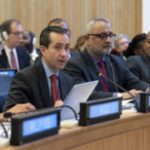
The MPI is transparent, it is a measure that can be easily understood by the population, and it’s a measure that serves as a tool for monitoring progress across a range of government actors.
All these new measures introduce new elements that will help us piece together the poverty puzzle, and help countries to prioritize their investments so they can provide better opportunities for all.
Laurence Chandy, Director of Data, Research and Policy, UNICEF
We’ve learned something really significant about the role of national multidimensional poverty measures when they are combined with age disaggregation to draw attention to the composition of poor households, and thus the condition of children–and the further benefits that then arise when child-specific multidimensional poverty measures are developed.
Saurabh Sinha, Chief of Social Protection and Employment Section, UN-ECA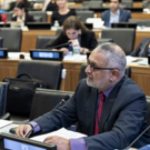
For the last few decades, if you see the growth of our understanding of poverty, it has really meant that we have understood poverty to be more than just a question of numbers of people below a certain consumption line. And so, as a result of our development of understanding of poverty, there is a need for measuring poverty in all its dimensions. To that extent, the Multidimensional Poverty Index plays a very important role.
In particular, in Africa, when we work with member states, we realize that the MPI provides and enlarges policy options, especially for some kind of fiscal decentralization. Because at the end of the day, what does the MPI do? The MPI is really providing us a more nuanced version of poverty. It provides a clear indication of what the drivers of poverty are.
ECA remains committed to working with member states in extending our understanding of poverty, extending our understanding of the dimensions of poverty, and what needs to be done to reduce poverty in all its dimensions in Africa.
Daniel Titelman, Director of Division of Economic Development, UN-ECLAC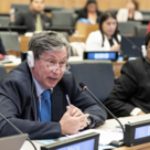
The MPI allows a better link between poverty analysis and social rights approaches on the one hand, and also it improves our capacity to evaluate public policies beyond income policies. So we think that this type of effort in terms of increasing not only the measurement, but also the understanding of the dynamics of poverty, is very important–[as] having a better understanding and better measurement of poverty will permit us to improve our policy capacity to fight poverty.
We are very happy that many countries in the region are moving in this direction, and we hope that we will keep moving with more countries and deepening the efforts in the countries that have already started this analysis.
Victor Harison, Commissioner for Economic Affairs, African Union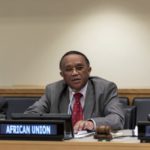
Although income poverty provides very useful information, it does not capture the multiple aspects that contribute to poverty, such as access to education, living standard, health, other non-income deprivations, and it does not really show how poor people are poor. The MPI goes beyond a traditional focus on income to reflect multiple deprivations to measure people who cannot reach the minimum internationally agreed indicators of basic functioning, such as education, health, and living standards.
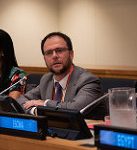 Gabriel Ferrero, Director of Sustainable Development Policies, Ministry of Foreign Affairs, Spain
Gabriel Ferrero, Director of Sustainable Development Policies, Ministry of Foreign Affairs, Spain
The experience of all the continents and especially in the Latin American community has shown that the multidimensional poverty index has been the best possible indicator for the evaluation of the first SDG, to guide public policies and to make reality the principle of not leaving to no one behind.
Since the 2030 agenda is universal and the use of the multidimensional poverty index is also transformative and useful for the OECD countries and for my country in particular where also the forms of poverty and social exclusion are a reality in many ways, Spain has considered the multidimensional poverty index in its voluntary national review that we carried out in July of this year in the high level political forum and we have included in our action plan for the implementation of the 2030 domestic agenda .
2018 UNSC | Side Event at UN Statistical Commission shows how MPI can break silos of poverty
The side event was chaired by Pali Lehohla, former Statistician-General of Statistics South Africa and Steering Committee member of the MPPN. Speakers included Directors of Statistics from Nepal, Philippines, Ecuador, South Africa, Tanzania, Mongolia, Uganda and Tunisia, with representatives also from Colombia, Rwanda and Egypt, as well as UNDP´s Human Development Report Office, UN´s Economic Commission for Latin America and the Caribbean, UN´s Economic and Social Commission for Western Asia and OPHI.
The event’s presentations will be added soon.
Highlights of each speaker’s points include:
Pali Lehohla, former Statistician-General, South Africa and Steering Committee, MPPN
- “We have a real treat tonight – a burst of information on how multidimensional poverty measures are being designed, disaggregated, and used in action to break the silos of poverty. For those of you who are here for the first time, you will leave here with a briefing on methodology and a map of exciting innovations in many countries.”
- “Multidimensional poverty is proving to give voice because it says ‘this is who we are, this is where we are, and this is how we are.’ So it gives voice to the poor and leaves no one behind.”
- “From observation, to monitoring, to planning, this is the challenge, I think, that we have to look at: What is the arsenal of tools that we can apply through multidimensional poverty into the planning processes?”
James Foster, Research Associate, OPHI and Oliver T Carr Professor, George Washington University
- “Why MPI has a very straight answer: poverty itself contains multiple forms with many dimensions. Who says that? UN member countries say this via the SDG process.”
- “It’s not just how many people are deprived, but also what they are deprived in. The different dimensions have to be examined in conjunction.”
- “MPIs provide a headline measure, disaggregations, interlinkages, to inform policy action, to complement monetary measures, to help leave no one behind.”
Full presentation is available here.
Suman Raj Aryal, Director General, Central Bureau of Statistics, Nepal
- “I think Nepal is one of the youngest countries to prepare an official National Multidimensional Poverty Index. We released our first figures a few months ago.”
- “There are fundamentally five motivations for Nepal to make a multidimensional poverty index: the first is to view the poverty through the different dimensions; the second is to assess the short-term effect of public interventions; the third is to understand the remittance effect; the fourth is to get an idea of the inter-sectoral linkages; the last one is, of course, to align with the SDG framework.”
- “Nepal decided to use the Global MPI as our National MPI with minor adjustments – that way we can compare with others, and also look within our seven new provinces”
Lisa Grace Bersales, National Statistician, Philippine Statistics Authority, Philippines
- “Poverty statistics are the most controversial official statistic we produce, so we really seek the guidance of this inter-agency committee, who are statisticians and economists.”
- “In the Philippines, poverty is a contentious issue, so we had to get the inputs from various groups, especially our national anti-poverty commission and also civil society, which had very strong ideas about which dimensions should be covered.”
Reinaldo Cervantes, Executive Director, National Institute of Statistics, Ecuador
- “In Ecuador, we are considering a new measure of poverty corresponding to our constitution…. our constitution mentions that the rights of people must be covered in multiple dimensions – education, health, employment, social security, habitat conditions, access to safe water, and others.”
- “Since the year 2017, we have two specific goals for multidimensional poverty reduction in our National Plan: first, reduce the multidimensional poverty rate from 35% to 27%; and second, reduce from 60% to 49% the multidimensional poverty rate in the rural areas.”
Risenga Maluleke, Statistician General, Statistics South Africa, South Africa
- “Between 2011 and 2016, poverty trends have diverged a lot more among municipalities.”
- “SAMPI helps to evaluate the effectiveness of poverty reduction, and, of course, it indicates the contributions of government social programs.”
- “We want to update the levels of disaggregation and use the SAMPI in policymaking.”
- “We are agreeing that we will come to meet in South Africa in October 2018 for the next MPPN Annual Meeting.”
Albina Chuwa, Director General, National Bureau of Statistics, Tanzania
- “We have been using the Global MPI in Tanzania for our national human development reports.”
- “Currently we are conducting our household budget survey, and now we want to establish our National MPI. We have engaged as many stakeholders as possible, including our development partners group.”
- “We are eager to join the group [of countries with National MPIs] and to see all these types of dimensions presented here.”
Ariunzaya Ayush, Chairperson, National Statistics Office, Mongolia
- “In Mongolia, we don’t have the official survey yet, but we have done a pilot survey.”
- “The outcome was quite high. When the income-based poverty measure was released in 2016, it was 29%, almost 30%. In the multidimensional poverty measure, the rate of deprivations for health was 42%, housing dimension was almost 60%, and standard of living was 40%.
- “Some of the selected indicators cannot express Mongolian conditions, maybe, and that could be the reason for the high MPI [relative to the income-based poverty measure]. Therefore, we understand that we need to organize more discussions with the related ministries and, of course, a multi-stakeholder group at the policy level.”
Full presentation is available here.
Ben Paul Mungyereza, Executive Director, Bureau of Statistics, Uganda
- “We have not started producing the MPI, but we have done the groundwork for producing the MPI. So far, we have created a Core Technical Team and a Community of Practice. The core technical team reports to the Ministry of Finance and it has members from the national statistics office, the planning authority, and the Economic Policy Research Centre. The core technical team is responsible for reviewing and computing the MPI, while the Community of Practice is mandated to engage the stakeholders and increase awareness among the stakeholders.”
- “The consultations we have had so far, the outcome is informing the dimensions and indicators that we need to address. And the areas that are clearly coming out that need to be addressed by the MPI: accountability, powerlessness, vulnerability, agriculture, housing, and education.”
Hedi Saidi, Director General, National Institute of Statistics, Tunisia
- “In Tunisia, we have developed, in coordination with OPHI and UNDP, a National MPI.”
- “Our MPI provides a strong tool to inform, monitor, and evaluate progress towards priorities that include employment, alongside living standards, health, and education. We incorporate these priorities into our Development Plan 2017-2020, and the MPI is designed to monitor it.”
- “The MPI tool will be used to monitor, evaluate, and adjust the National Plan and its related social economic programs by targeting the most important vulnerable populations in an efficient way.”
Full presentation is available here.
Carlos Felipe Prada, Deputy Director, Administrative Department of National Statistics (DANE) Colombia
- “The numbers of poverty in Colombia have been decreasing. We are working and thinking, because we have some indicators that are close to 100%… So, we are trying to have a new index in a couple of years.”
- “In Colombia we have an expert committee on poverty and multidimensional measurement that includes academics and some other government institutions and receives comments from civil society.”
- “We want to have the MPI disaggregated at the lowest municipality. With this census, with the national household surveys in Colombia, we can have the MPI measure for each municipality in Colombia and each village in the rural areas of Colombia. For us, it is a tremendous advantage and a tremendous improvement in our measurement because we want the MPI measure to have results for each department in Colombia.”
Full presentation is available here.
Ivan Murenzi, Deputy Director, National Institute of Statistics, Rwanda
- “Rwanda is a very small, developing country, but with great ambitions. And poverty is definitely one of the key, key issues that the leadership is committed to tackle.”
- “For our recent results, which we hope to release sometime in August or September, we will be disseminating results of monetary poverty as well as multidimensional poverty. So, one key issue I had in my mind is how do we package this together?”
- “In Rwanda, we usually have an annual leadership retreat, which brings together all government leaders. And it was amazing to see from some of the discussions we had through the Ministry of Finance, Ministry of Health, how this multidimensional assessment of poverty begins to bring everyone on board when we talk of poverty. Previously, in my view, monetary poverty has been more seen as an issue for the Ministries of Finance and Planning, but what multidimensional poverty is doing is bringing all the other stakeholders, from all corners, together.”
Heba Saied, Statistician, Central Agency for Public Mobilization and Statistics, Egypt
- “Poverty is not only monetary metrics, but there is a global trend to define poverty as the lack of access to services or deprivations in other aspects of life.”
- “Why do we use the HEICS [Household Expenditure and Income Survey] for our MPI? The HEICS provided non-monetary data about many indicators that are useful for multidimensional poverty measurement, as well as household expenditure and consumption. Also, the period of the survey is every two years, which allows for continuous monitoring of the conditions of the poor.”
Full presentation is available here.
Selim Jahan, Director, Human Development Report Office, UNDP
- “There is no need to emphasize once again that poverty is multidimensional. We all know that. But, at the same time we need a measure for that multidimensional poverty because often it is said that what we cannot count, is not counted.”
- “We started the journey on the Multidimensional Poverty Index, or MPI, back in 2010. When HDRO and OPHI started that journey through collaboration and worked over the years to publish and disseminate the results in the HDRs. Over the years, there have been some differences in methodologies, and there was the HDRO methodology and the OPHI methodology, but over the last year, Sabina and I and both our teams have discussed it over and over and found out that the differences were minimal and trivial, in some cases, if I may say so. Therefore, we have now decided to have one Global MPI methodology.”
- “As in the movie Casablanca, the last line was ‘Louie, this is the beginning of a longstanding friendship,’ and, with that I say that with OPHI and HDRO, this is also the beginning of a longstanding friendship, the results of which will be reflected in new generations of the HDRs.”
Pascual Gerstenfeld, Director, Statistics Division, UN-ECLAC
- “We are close to 60 persons, at this time, in New York, in a storm, talking about how to measure poverty.”
- “In 33 years, this [the MPPN] is the strongest network I have been involved in… When we began in 2013, there were fewer than 20 countries and five institutions, but now we are 53 countries and 15 institutions in less than five years. This is a real network. The word ‘Network’ is very strong and really, really important.”
- “We are working together now in four of the five regional commissions – ESCWA, ECA, ESCAP, and ECLAC – on a study of availability, comparability, and quality of indicators for monitoring goals 1.2 and 1.4.”
Marwan Khawaja, Chief, Demographic & Social Statistics, UN-ESCWA
- “The Arab Multidimensional Poverty Report was released a few months ago, at the end of 2017… The main goal was to develop an MPI tailored to middle-income countries, which a majority of Arab countries are.”
- “We wanted this MPI to serve as a foundation for developing a poverty reduction strategy.”
- “The report was produced with the League of Arab States, and that implies that the member states of the League had to endorse the report.
Sabina Alkire, Director, OPHI
- “Many countries have launched their MPIs as an official permanent statistic of poverty that goes along with the monetary poverty measure. That has to go through a number of internal processes, so it becomes an official statistic – and one that is used by policy at the highest level to drive action and reduce disadvantages effectively.”
- “Besides statistical reports, Voluntary National Reviews and the High Level Political Forum are places countries are sharing how the MPI can be used for policy.”
- “Many countries are wanting to report their MPI for SDG indicator 1.2.2.”
- “The MPPN [Multidimensional Poverty Peer Network] is a South-South network that was launched in Oxford by Amartya Sen, Nobel Laureate in Economics, and President Santos of Colombia, that tries to have both statisticians and policymakers share their experiences in developing an MPI. You are all welcome to join and share your insights with us on how best to fight poverty in all its dimensions.”
Full presentation is available here.
Photo gallery:
Click on the image to enlarge














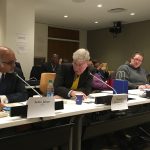
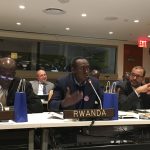
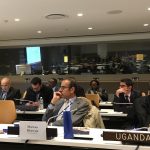
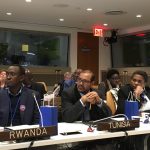
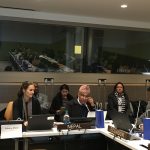
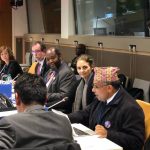
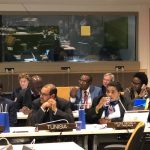
Recent Comments